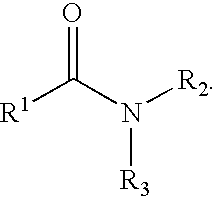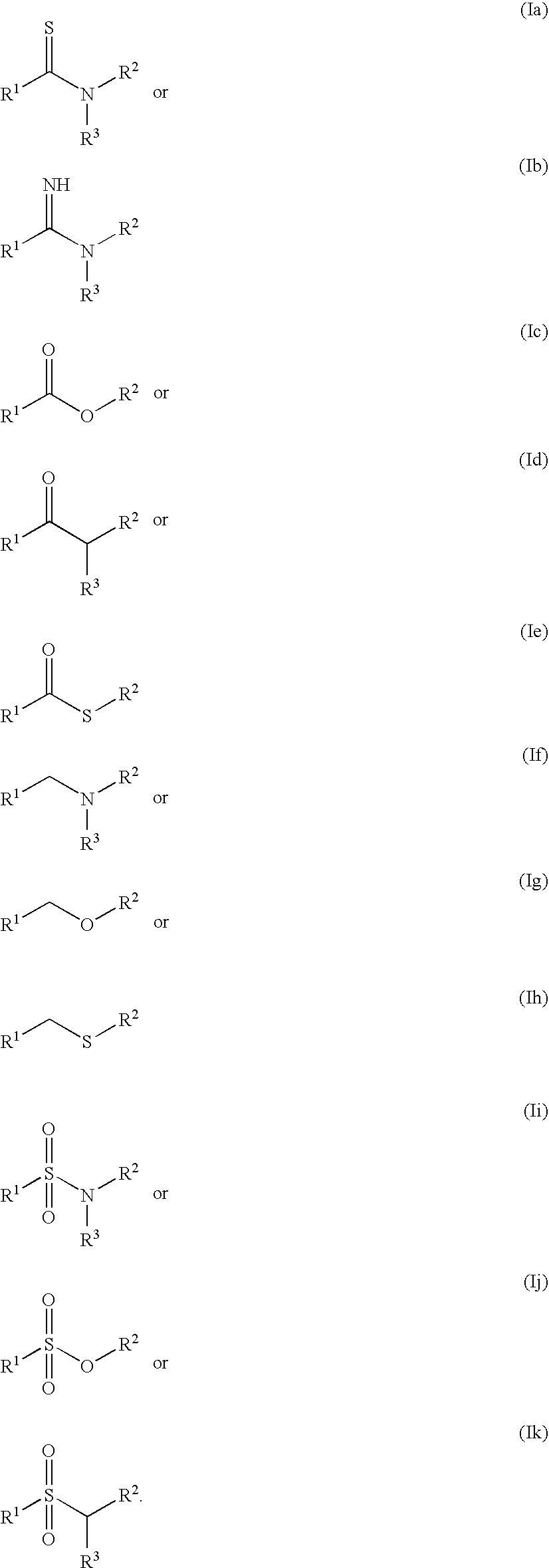Molecules comprising linked organic moieties as flavor modifiers for comestible compositions
a technology of organic moieties and molecules, applied in the field of flavor or taste modifiers, can solve the problems of poor understanding of the biochemical basis of taste perception, msg is known to produce adverse reactions in some people, and little progress in identifying artificial substitutes for msg, so as to modulate the flavor or taste thereof, and enhance the savory and/or sweet taste thereof.
- Summary
- Abstract
- Description
- Claims
- Application Information
AI Technical Summary
Benefits of technology
Problems solved by technology
Method used
Image
Examples
example 1
Umami Compounds
N-(heptan-4-yl)benzo[d][1,3]dioxole-5-carbothioamide
[0430]
[0431] To a solution of 132 mg (0.5 mmol) N-(heptan-4-yl)benzo[d][1,3]dioxole-5-carboxamide (example a) in 5 ml of toluene was added 303 mg (0.75 mmol) of Lawesson reagent and the mixture was stirred at 65° C. overnight. To the cooled mixture 5 ml of toluene was added and a solid was filtered off. The toluene was washed with sat. NaHCO3, water and dried over MgSO4. A crude product, obtained following evaporation, was further purified on silica gel to give the title product as a white solid (85 mg, 42%). 1H NMR (500 MHz, dMSO): δ 0.86-0.90 (t, 6H), 1.29-1.34 (m, 4H), 1.52-1.64 (m, 4H), 4.67-4.70 (m, 1H), 6.08 (s, 2H), 6.93-6.95 (d, 1H), 7.28-7.30 (m, 2H), 9.74-9.76 (d, 1H). MS (M+H, 280.1).
[0432] a. N-(heptan-4-yl)benzo[d][1,3]dioxole-5-carboxamide: To a solution of heptan-4-amine (8.06 mL, 54 mmol) in triethylamine (15.3 mL, 108 mmol) and dichloromethane (135 mL), was added, dropwise at 0° C., a solution of ...
example 2
(1-(4-ethoxyphenyl)-3-(2-(pyridin-2-yl)ethyl)thiourea
[0434]
[0435] To a solution of 1-ethoxy-4-isothiocyanatobenzene (40 uM, 1 eq) in 1,4-Dioxane (400 uL), was added 2-(pyridin-2-yl)ethanamine (40 uM, 1 eq) in 1,4-dioxane (400 uL). The reaction mixture was shaken at room temperature overnight. Next a 64:36 w / w mixture of PS-NCO (1.63 mmol / g) and PS-trisamine (3.2 mmol / g) was made and 50 mg of the above mixed resins were added to the reaction and the mixture shaken at 50° C. for 5 h. The resulting suspension was cooled down to room temperature and filtered. The solvents were removed under reduced pressure to provide (1-(4-ethoxyphenyl)-3-(2-(pyridin-2-yl)ethyl)thiourea in 32% yield (100% purity by LC / MS).
[0436] The compound had EC50 for activation of a hT1R1 / hT1R3 umami receptor expressed in an HEK293 cell line of 0.55 μM.
[0437] Additional compounds that were synthesized (A1-5, 15-19, 21) or purchased [A6, 7, 8, 10, 13, from Ryan Scientific of Isle of Palms, S.C.; A8 from Aldrich o...
example 3
1-(4-Isopropoxyphenyl)-3-(thiophen-3-ylmethyl)thiourea
[0446]
[0447] To a solution of 1-isopropoxy-4-isothiocyanatobenzene (example 1a) (193 mg, 1 eq) in acetonitrile (3 mL), was added, thiophen-3-ylmethanamine (97 mg, 1 eq). The reaction mixture was placed in a microwave reactor and was microwaved for 5 minutes at 150° C. The product was purified by reverse phase HPLC. Solvent system: acetonitrile / water (10% to 100% gradient), 10 minutes run. Yield: 52%. 1H NMR (500 MHz, DMSO): a 1.25 (d, 6H, J: 6 Hz), 4.55 (m, H), 4.67 (d, 2H, J:5.6 Hz), 6.86 (d, 2H, J:6.7 Hz), 7.11 (dd, 1H, J1:1.3 Hz, J2:4.93 Hz), 7.19 (d, 2H, J:8.9 Hz), 7.32 (dd, 1H, J1:0.9 Hz, J2:2.9 Hz), 7.48 (dd, 1H, J1:3.0 Hz, J2:4.9 Hz); 9.35 (br s, 1H). MS(M+H, 307). Melting Point: 80.5-81.5° C.
[0448] The compound had EC50 for activation of a hT1R2 / hT1R3 sweet receptor of 0.15 μM.
[0449] a. 1-isopropoxy-4-isothiocyanatobenzene: To a solution of di(2-pyridyl) thionocarbonate (2.3 g, 1 eq) in dichloromethane (150 mL), was ad...
PUM
 Login to View More
Login to View More Abstract
Description
Claims
Application Information
 Login to View More
Login to View More - R&D
- Intellectual Property
- Life Sciences
- Materials
- Tech Scout
- Unparalleled Data Quality
- Higher Quality Content
- 60% Fewer Hallucinations
Browse by: Latest US Patents, China's latest patents, Technical Efficacy Thesaurus, Application Domain, Technology Topic, Popular Technical Reports.
© 2025 PatSnap. All rights reserved.Legal|Privacy policy|Modern Slavery Act Transparency Statement|Sitemap|About US| Contact US: help@patsnap.com



